Switzerland
Switzerland
The following Nativities are each displayed in a unique permanent setting created by Marian Library Crèche Collection volunteers. The descriptive text for each was written by Father Johann Roten, S.M.
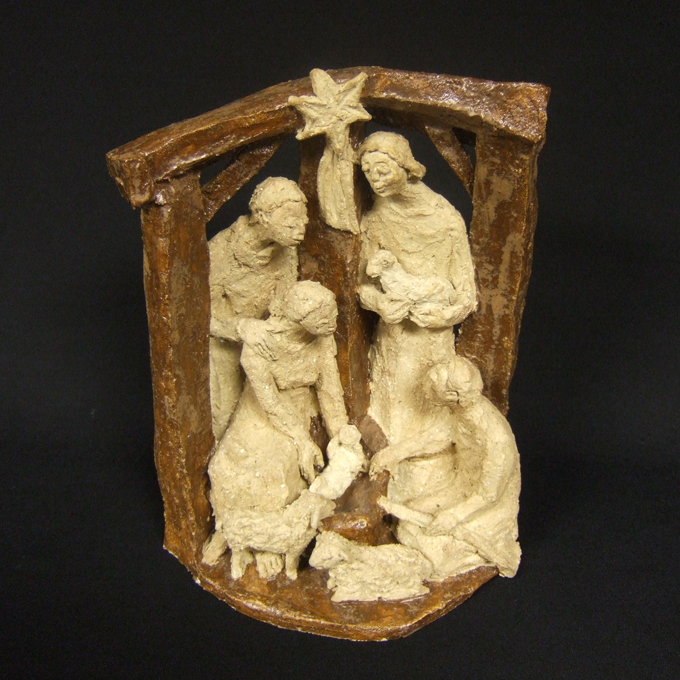
In Search of Truth
Caritas Müller
Part rough and part glazed, this set was made for the Marian Library Collection by Swiss artist Sr. Caritas Müller. It consists of two panels. The one to the left pictures the Holy Family. The two figures of the panel to the right are shepherds. Mary is involved in conversation with one of the shepherds. She emphatically points to the child. The shepherd wants to know: who is this child? Mary tries her very best to explain. In search of truth, this question has been asked by many visitors of the crèche, for centuries on end. Mary still explains, engaging visitors in a “sacred conversation” where faith and truth are bonded.
– ML.0110.18
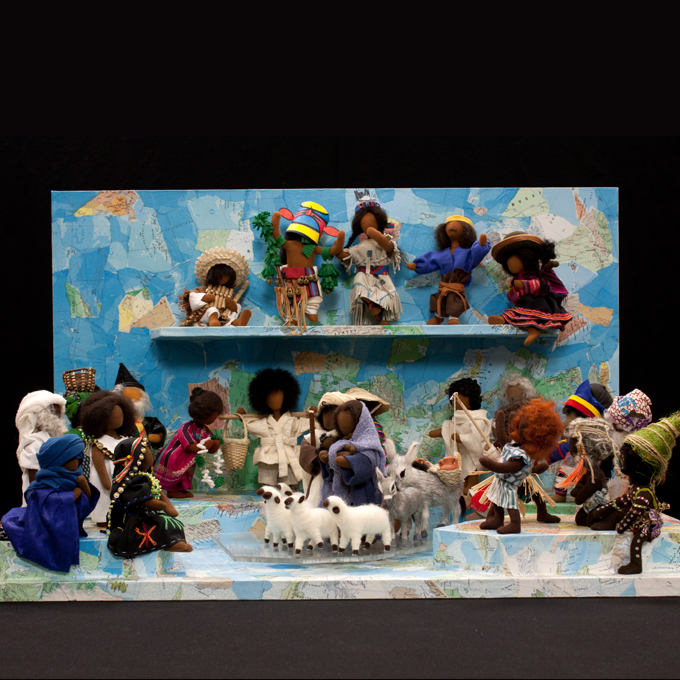
A Nativity for the Whole World
Bernadette Roten
The Holy Family accompanied by sheep and donkeys is again on the move. But their travel is no longer the flight to Egypt or the shelter-seeking in Bethlehem. The journey takes them to the ends of the world, to North and South, East and West; to the five continents of this earth. Each of the continents is represented with five figures illustrating history and culture, beauty and poverty; those who made history and those who were forgotten by it. The figures are faceless, not to point out anonymity but universality.
– ML.1111.02
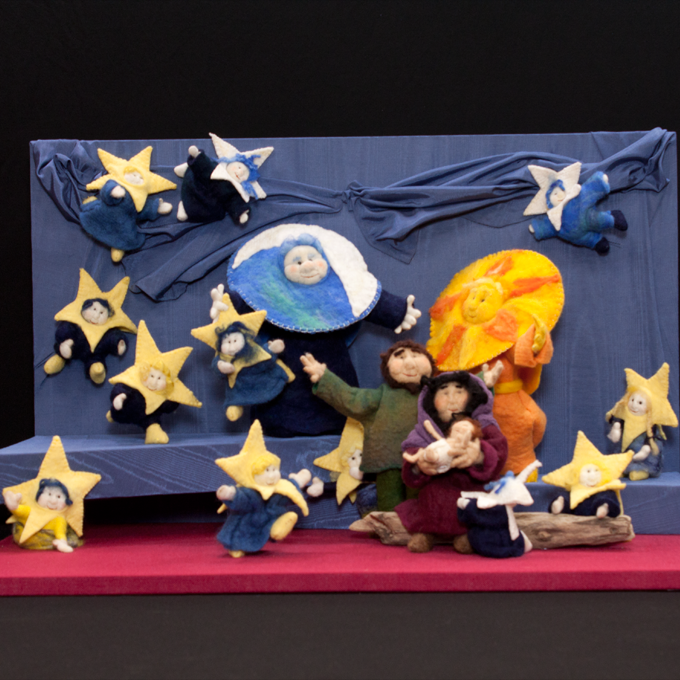
Sun, Moon, and Stars
Bernadette Roten
Inspired by the Scandinavian saga of trolls, this nativity set suggests cosmic proportions. Trolls were believed to have supernatural powers. They were creatures of the night coming out of their hiding places after sunset, and disappearing before the morning sun pointed its face. Awe-inspiring and wrathful, trolls had the ability to transform themselves. This set shows a kinder breed of trolls with flat noses and laughing eyes. They are no longer creatures of the dark but bearers of light. Little stars, they perform a ballet of humor and grace. Posing as sun and moon, they establish authority over the light of day and that of night. Christmas is a festival of light, and is the message of this scene.
– ML.1117.05
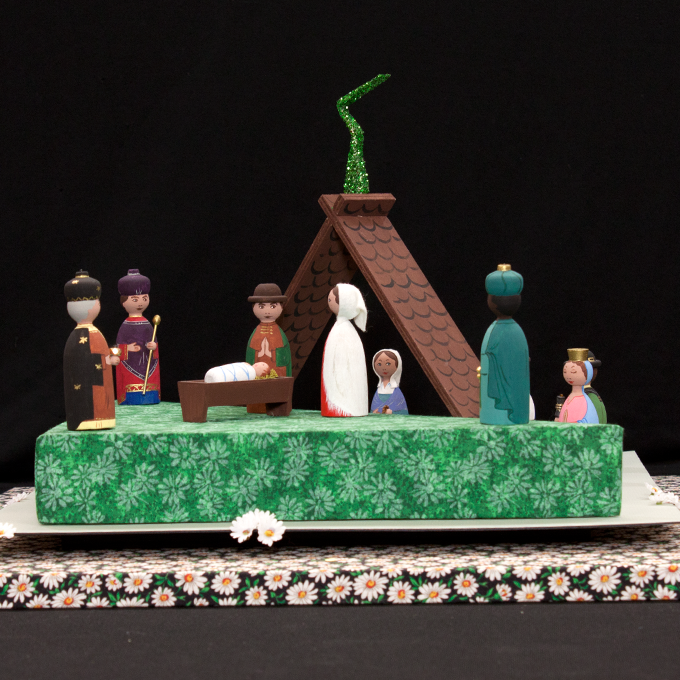
Trigonometry
Elizabeth Kuchen
Trigonometry is a branch of mathematics and apparently has nothing to do with Christmas. But have a closer look a this nativity. The magi-kings are arranged in a triangle. The ground they tread is of triangular shape; Mary, Joseph and the cradle are aligned according to the same geometric pattern. The hinted at house, in fact, is a gabled roof. Even the lightning rod suggests an open triangle.
We like it neat and orderly. Our mentality is readily espousing what Pascal called the spirit of geometry. We tend to organize life on a drawing-board and to put people into labeled boxes. The spirit of geometry has its positive side; who would want to doubt it! We need some law and order in society, but there is no way of cloning individual history and the consequences of abuse. God would be dead, if we should ever declare Him demonstrable. Pascal counterbalanced the spirit of geometry with spirit of finesse, meaning in French a sense of empathy, the ability to see with the eyes of the heart, to be gifted with depth perception. This nativity scene suggests the same balance. From the carpet of little daisies to the brightly painted figures with chubby cheeks and funny hats, there is a subtle message springing from this set: There is more to Christmas than trigonometry.
– ML.0118.08
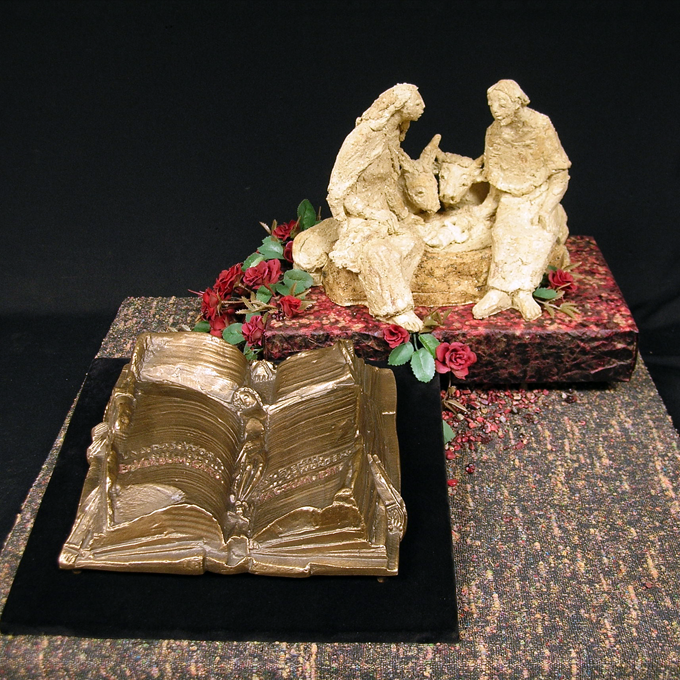
Cradle and Cross
Caritas Müller (Switzerland); Hans Wachter (Germany)
Cradle and cross are never far apart in Christian thought. The first leads to the second, as certain as Christmas leads to Easter. At first sight, this double set is made of contrasts. Stoneware clashes with bronze, and the lovely nativity group seems to disagree with the stylized forms of book and cross. In fact, there is complimentarily in color and weight: both lend a discreet nobility to the book as well as to the cradle. The delightful idyll of parents and animals gathered around the child is not without foreboding. The insouciant animal companions contrast somewhat with the more reflective parents. They seem perplexed and helpless, somehow anticipating the next scene with the crucified Son at its center. Tucked between the pages of the book of life, the Savior on the cross looks like a pressed flower. He is a constant reminder that the many pages of his message are drawing their fullness of meaning from his death and resurrection. Thus, cradle and cross have a twofold meaning. They both speak the language of Christmas and Easter.
– ML.0110.14
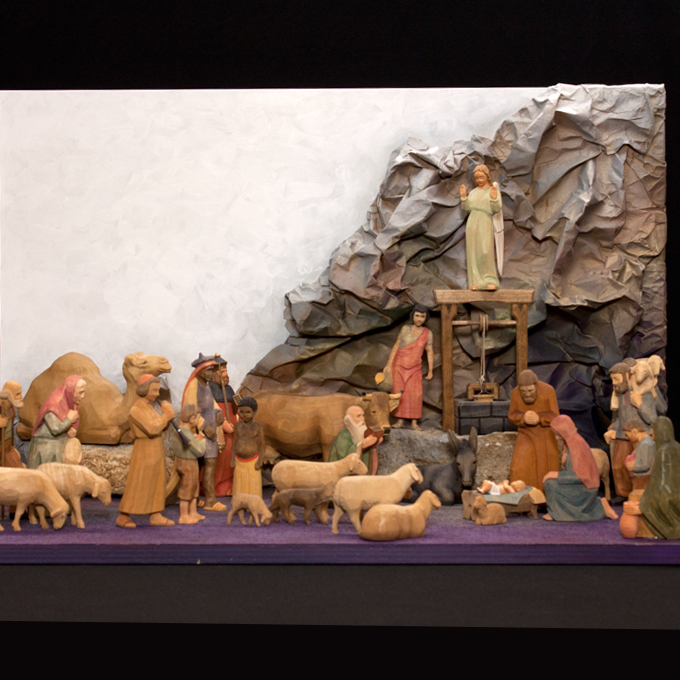
Twins
Hans Huggler
Huggler is the name of one of the better-known woodcarver families in the Bernese region of Switzerland. Their figures have the measured elegance of well-to-do farmers. Postures are grave and reverential, all movement suspended in pious tribute to the Christ child. The subdued colors heighten the overall impression of devout this- worldliness.
There are two identical figures in this set: two shepherds, each carrying a sheep on his shoulders. These are the Twins, bearers of human challenge. Turned unto ourselves we see but ourselves. We are like twins, for wherever we look and whatever we do, we only see our own face and personal interest. Healing comes from the Child in the manger. He is the epitome of holy altruism. He frees us from our twin, meaning our other, darker self. Reflecting on the bitter experiences of human existence, this Germanic crèche tradition points beyond mere sociology and culture to the deeper recesses of the human psyche.
– ML.1718
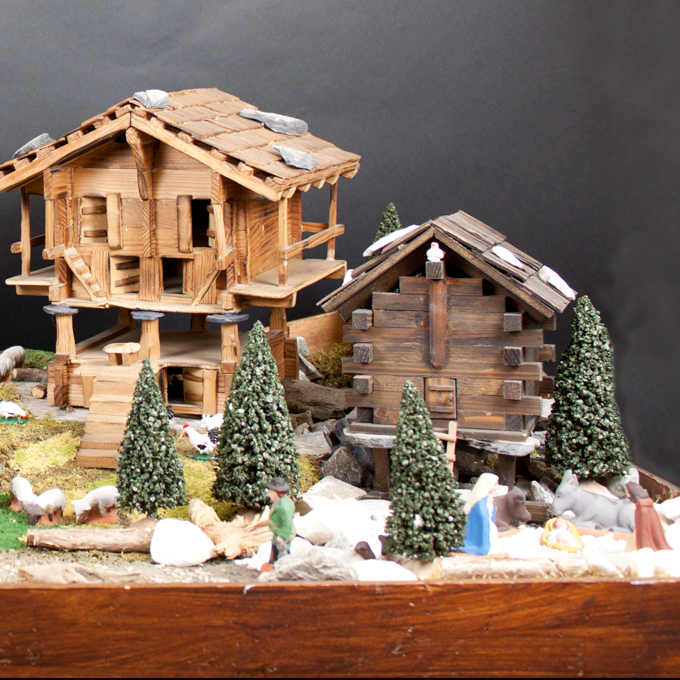
From the Mountain Tops
Gilberte Schneider
– Alpine Regions of Europe
The central feature of this nativity is the typical habitat of the Alpine regions of Europe. These wooden constructions, burnt a deep brown or black as they grow older, are covered with slabs of granite or wooden shingles. They are built on stilts topped by circular slabs of granite to prevent mice from penetrating apartments and storage rooms. Buildings where people live are separated from granaries and stables. Similar constructions can be found in northern Spain and countries of the Pacific rim. The houses of this nativity are set in the barren landscape of the pre-Alps where grass and trees are sparse, but rocks, sheep, goats and old people, left behind, are many. Here, the Holy Family finds refuge in a shelter used by shepherds and sheep. The birth of the Messiah needs to be proclaimed not only to cities and on the flat lands but also from the mountain tops.
– ML.0251.02
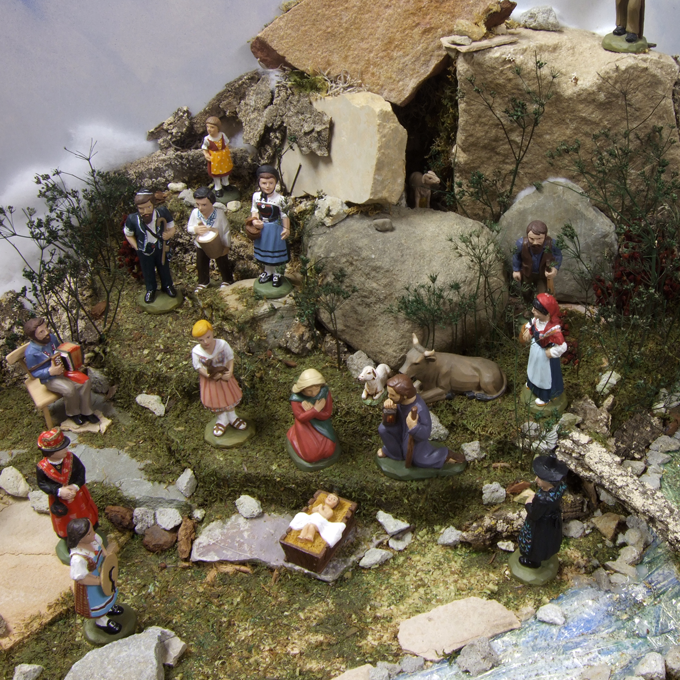
Swiss Santons
Barmettler Family
Santons are messengers of people’s customs and concerns. This nativity scene is a study in Swiss folklore. It shows some of the historical trademarks of Switzerland: the unforgettable Heidi, the accordion player, and the typical Swiss dairy farmer. But the host of actors and actresses represent the folkloric costumes of various regions of Switzerland. Most of them are from central Switzerland (Uri, Schwyz, Luzern), others from the northern regions (Zurich, Appenzell), still others from the southern (Wallis, Tessin) and western (Vaud, Fribourg) parts of the country. All together, they form a colorful and impressive parade of Swiss folklore. However, this nativity set presents a major challenge: poor baby Jesus and parents beg to be sought and found.
– ML.0158.13
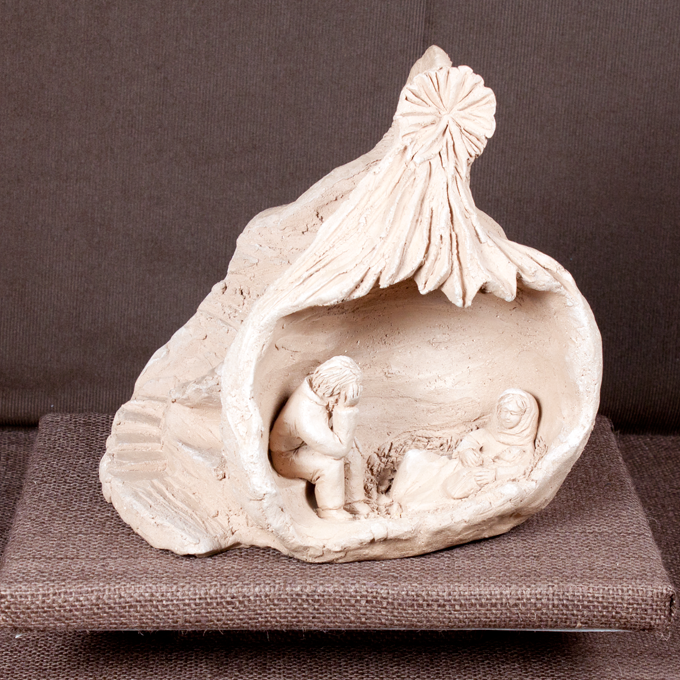
The Magic Lantern
Matthäa Wirz
Have you seen a multi-purpose nativity before? It has a handle and is portable. It holds not only one but three scenes. The nativity scene is complemented by those of the Annunciation and the Crucifixion. It looks not only like an exotic fruit or flower, ripe in some parts and open, but also like a magic lantern. One cannot look at one image without being attracted by the others. The angel of the Annunciation appears to Mary in a cave, growing literally out of the wall. The cave is reminiscent of the nativity grotto where Mary rests in a reclined position holding the Child in the nook of her arm. In this set and in older nativity traditions, Joseph sits pondering in a distance. The nativity is the beginning of a long and arduous journey, ending at the top of many stairs, but leading through death into the light of the resurrected Christ and Sun of Justice. It is not without meaning that this magic lantern has a handle. The light of salvation needs to be carried wherever we go to brighten our path with its memories of promise (Annunciation) and fulfillment (Crucifixion and Resurrection). This is what Christmas stands for.
– ML.0139.09,10,11
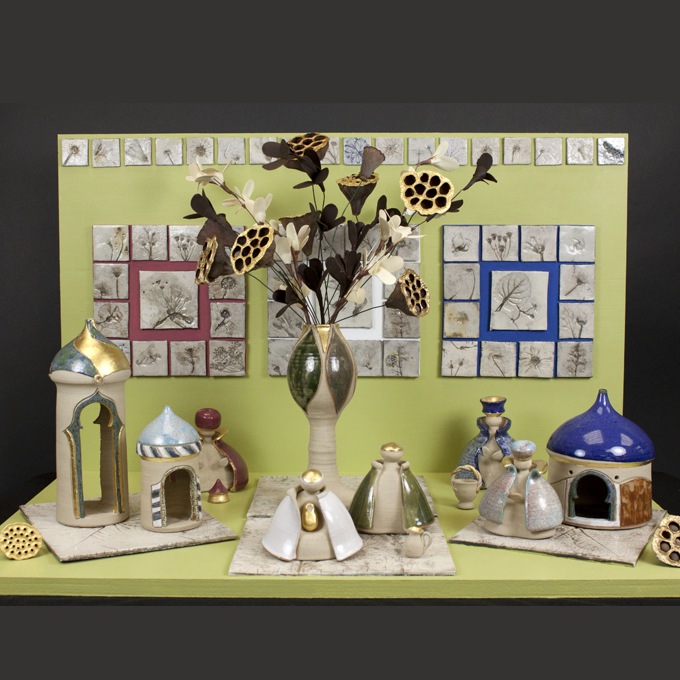
Anonymous Christmas?
Verena Hirt
This nativity set is culturally, as well as geographically, anonymous. Although made in Switzerland, there is no telltale sign of a special tradition, cultural origin or geographical pattern. Unless anonymity itself could be considered a special tradition! Among contemporary artists crafting crèches, there are some who avoid any contact with local customs and all too human faces. Their reasoning needs to be pondered, for who knows how it really was? And there is more to be pondered. Who would be able to make the mystery visible with all these too familiar faces and customs? Verena Hirt's answer is that of the beauty of the form leading the viewer to the discovery of the mystery of Christmas. The figures with their anonymous faces and their half-open and windblown mantels play hide-and-seek with our imagination. Is God the hidden one? How much of him is revealed? The beautiful ceramic towers with their pointed domes and wide-open doors are an invitation to explore the mystery of this God who hides himself in a baby. For once anonymity leads into mystery, not for lack of knowledge but rather because of an abundance of grace.
– ML.0137.04
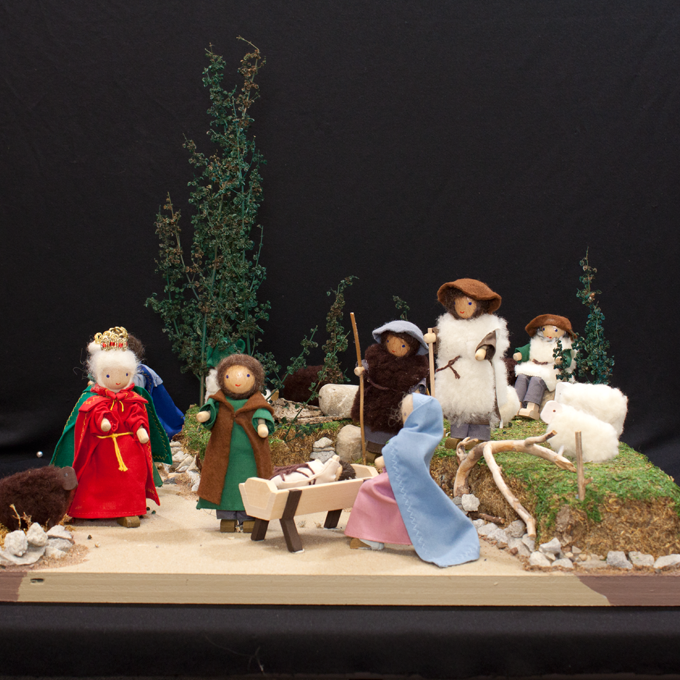
A Children's Play
Evi Amrein
Christmas in many ways takes us back to our roots: to the beginnings of life, to childlike innocence and original blessing. This makes of Christmas a feast for children and childlike souls. It is not always easy to believe in the deep-down goodness of people and things, and so it is frequently a children's privilege to keep the miracle alive. This nativity set is a tribute to children's playfulness and carefree wonderment.
– ML.0181.18
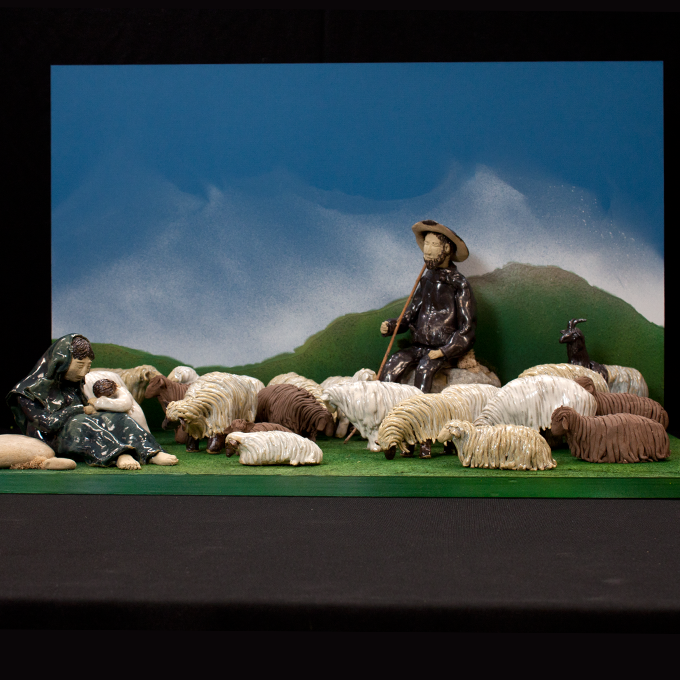
Counting Sheep
Franziska Torti
Why should there be only one way of displaying visually the message of Christmas? Jesus grew up among sheep, and took a special liking to them. He referred to their life and habits in parables. Thus, why couldn't we imagine him being a young boy cared for by his mother and protected by a friendly herd of sheep? Or did he grow tired and sleepy from counting sheep? Saint Joseph, somewhat stiff and out of his depth as amateur herdsman, is watching over them all.
– ML.1820
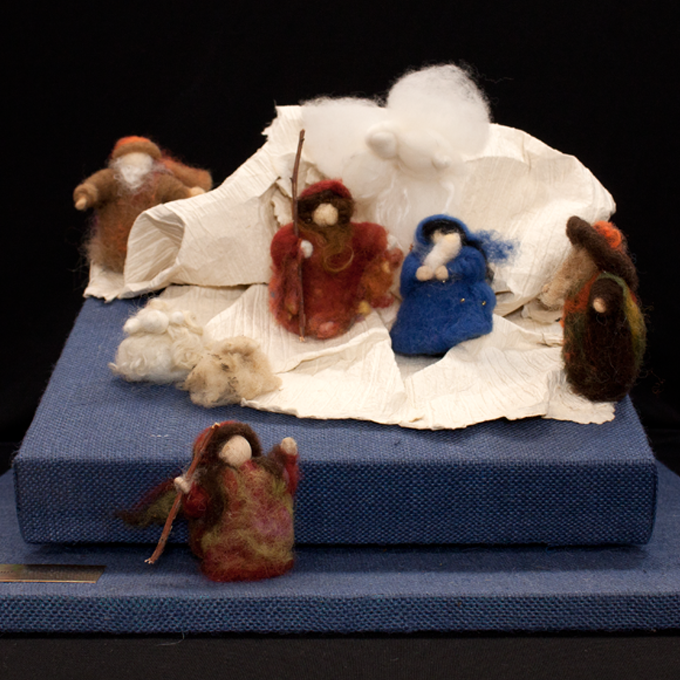
Dyed in the Wool
Katrin Barendregt
Faceless and almost formless, these figures are representative of a recent tendency in crèche culture. The tendency is termed “narrative simplicity,” and calls for simple and natural materials to embody and represent the Christmas story. In this set, the material is wool, nothing but bits and pieces of pure and dyed wool. But wool adds a secondary, a moral significance to the story told by these woolen figures. The word “wool” in German is at the heart of a number of proverbs expressing rage, quarrelling, getting in each other’s hair, being at loggerheads with somebody. Thus, wool is a reminder that the message of Christmas is a message of peace and not of quarrelling. A dyed-in-the wool Christian is a lover of peace.
– ML.1118.08
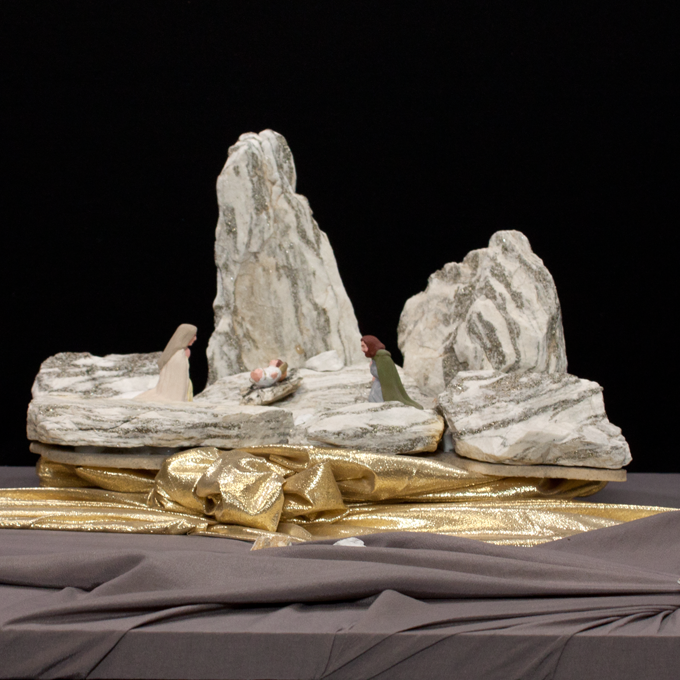
Back to the Essentials
Gilberte Schneider
Three Santons, and not much else! Gilberte Schneider chose these humble “little saints” – Jesus, Mary, and Joseph – to make her point. Imagination is particularly fertile when it comes to accessories, simply because the essentials cannot or should not be changed. But accessories sometimes hide or obscure the essentials. Thus, there is welcome relief in showing but the essentials. The Holy Family is set against a lunar landscape of bare white rocks streaked with yellow mica from the Alpine regions of Switzerland.
Over time the nativity tradition expanded to include ever more cultural and thematic elements. Figures from scripture and local culture were added. Cave or stable became a ruin, then a village or sometimes a whole town. And although the nativity remained the center, this center was frequently obstructed or obscured by too many secondary figures. Thus, it sometimes comes as a welcome relief to find crèches where nothing but the essentials are shown. The example we present is composed of Jesus, Mary and Joseph clothed in simple robes of subdued colors. The Holy Family is set against a crown of bare white rocks streaked with yellow mica or cat gold. There is no distraction for mind or eye. Everything is centered on the essentials: its sober beauty and challenging simplicity.
– ML.1118.19
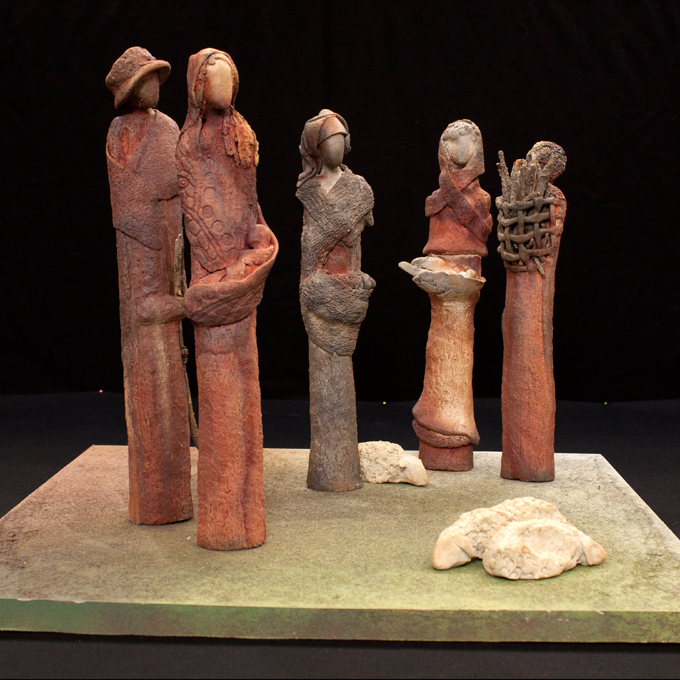
A Wonderful Exchange
Tilde Biner
Contemporary Nativity sets from Western Europe, which pride themselves of some artistic ambition, have a tendency to avoid figurative representations. It is the conviction of this artist that Nativity figures need to be reinvented over and against familiar patterns and comfortable projections. Resonating with A. Giacometti's artistic creed, Tilde Biner reduced matter to its furthest viable limit and form to a minimum of movement. The result is one of heightened expressiveness. The tall and lean figures of Mary (with the Child) and Joseph are messengers of a fragile but tender message. They are pilgrims of the "Good News" but also its possible and sometimes likely victims. The group of the three women is a monument of attention and tension, a lively but equally fragile counterpart of the migrant couple. The women bear gifts to cover the Holy Family's simple needs. This set raises a question but gives no answer. Will the exchange take place or not? Will the message of the "Good News" pass? Will the women present their gifts to the Child? In sum, will the "wonderful exchange" -ultimate meaning of the Incarnation – become reality?
– ML.2638
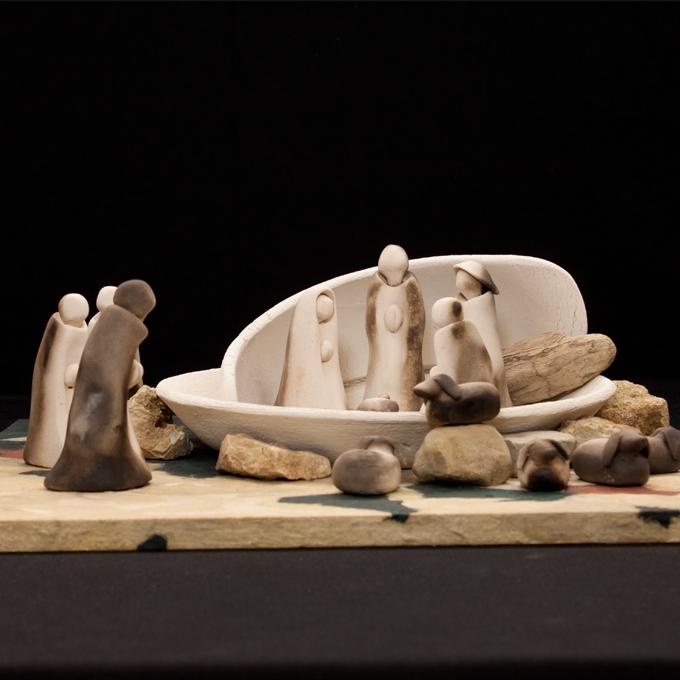
A Face of Your Choice
Anne-Marie Frey-Urech
There is no photo-ID to identify the Holy Family. Puzzled, the adult capitulates and creates faceless figures. Popular in religious art of the 1960s and 1970s, gesture and posture define the actor. Faces remain blank—a standing invitation to paint the eyes, nose and mouth of your choice.
– ML.0108.25
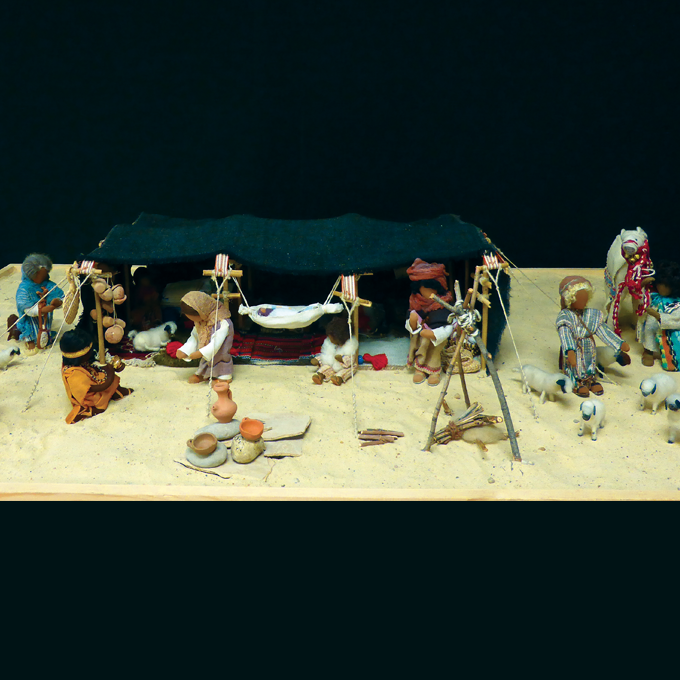
God Will Conceal Me in the Cover of His Cloak (Tent)
Annuntiata Bregy (additional figures added by Bernadette Roten in 2011)
Although designed in Switzerland, this set recreates a Bedouin scene, complete with a square, black tent and household goods. The intent was to show the intimate connection between God's promise and its fulfillment in Christ. Following Yahweh's call and promise, Abraham left his townhouse in Ur and lived in a tent. Ultimately, his journey of
faith led to the announcement to Mary and the birth of Jesus. The tent is the symbol of this journey. God lives in a tent, even in churches of stone. He lives in the tent of history and its ever-changing face. He lives in the fragile walls of our frequently shaky faith. He lives as memorial of our salvation in our mortal bodies. The figures are left faceless, not to point out anonymity, but universality. We need to give the Christ event a face, our own face, and the face of all those of good will.
- ML.0102.06.14
